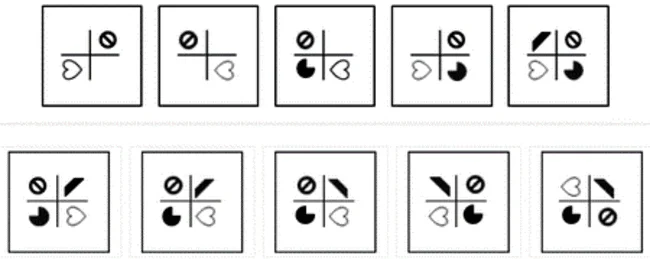- 23 inductive reasoning tests
- 9 abstract reasoning tests
- Solving strategies & score reports
- Video tutorial
What Are Inductive Reasoning Assessments?
Inductive reasoning tests are popular screening assessments used by employers as part of the assessment process. They provide valuable information on the way you think and react to new rules and situations.
The questions often require you to identify patterns of rules in diagrams. Often there is an overlap between concepts in inductive reasoning and diagrammatic reasoning.
Most employers use these tests when recruiting for most positions within their company. It is a test that can be used to check performance and ability for all positions from graduates and managers to executives.
Important Facts on Inductive Reasoning Tests
- Assessment companies use many terms (abstract, inductive, diagrammatic) to describe similar test styles.
- Inductive reasoning in the narrow sense of job selection asks to identify a pattern or consistency among sets of objects and predict what is the next expected object in the sequence.
- The most popular forms of inductive reasoning tests are matrices, horizontal shape sequences, A/B sets and odd-one-out sets.
Inductive Reasoning Examples
💡 Practise Inductive Reasoning with our Raven's Progressive Matrices Practice Test, or the Free SHL Practice Test
Here is an example of an inductive reasoning sequence, often found in pre-employment selection tests. Please look at the top row. The frames advance from left to right in a certain way. Try to predict the next shape in the sequence from the options listed in the second row.

Types of Inductive Reasoning Tests
Most assessment companies develop and offer inductive reasoning tests to employers as part of their recruitment solutions. While most tests are based on the same underlying principles, the differences between one test style and another are substantial. Here are links to pages that elaborate on test styles of leading assessment companies:
Other inductive reasoning tests that use matrices to assess your thinking skills are the Alva Labs Test and Raven's Progressive Matrices.
There are two main aspects that are worth mentioning. First, you are being assessed on General Mental Abilities (GMA).
This means that even though the questions in this test have no relevance to the job you have applied for, they are a good predictor of job performance.
Psychologists claim that if you score well on this test, you will be able to show a similar level of performance across a wide range of activities in the workplace.
The second aspect is that proponents of this test claim it cancels cultural or linguistic differences. After all, no reading or prior knowledge is required. For this reason, inductive reasoning tests are viewed as a more impartial measure of ability, hence their popularity among employers.
Practicing for Inductive Reasoning Tests
Practicing for an inductive reasoning test in advance has many advantages, the three most important ones are:
- Exposure to logic patterns that lay the foundations for inductive reasoning.
- Familiarisation with recurring principles and methods, which can be recognised quickly in the real test.
- Improvement of response times and confidence.
JobTestPrep offers an extensive practice package for inductive and abstract reasoning tests, with over 650 questions. If you are preparing for your assessment day or any other selection test, this practice pack can increase your qualification chances.
JobTestPrep's online practice for Inductive Reasoning Tests is a full pack containing inductive and logical abstract reasoning questions designed to examine rational thinking. The tests included in this pack help you practice your ability to form logical rules and propositions according to visual examples.
Deductive and inductive reasoning tests are popular aptitude tests seen on many job selection processes. Here we explain the differences between the two test styles and refer you to relevant practice resources.
Put simply, inductive and deductive reasoning are opposite directions of thought used for data analysis. Let's define each term first:
- Inductive reasoning: the inference of general rules from particular instances.
- Deductive reasoning: the inference of particular instances from a general rule.

What Do the Tests Look Like?
In the world of job assessments and aptitude tests, these two reasoning types will be assessed through different question formats. Inductive reasoning: Mainly shape sequences and matrices. Deductive reasoning: Verbal passages and numerical/tabular data (see an example here).
Who Is Expected to Take Each Test?
Inductive reasoning: almost any job applicant. This is because these tests evaluate general intelligence in a non verbal context. Deductive reasoning: finance, managers, analysts. This is because deductive reasoning evaluates analytic skills that are part of the daily tasks of these job positions.
Recommended External Resources
- This is great PDF brochure by SHL, which shows what types of questions appear on their deductive reasoning assessments. Our deductive reasoning practice pack follows these question styles.
- This is a great article by Diffen, that goes deeper into the scientific differences between the two modes of thought.
- A free SHL test practice that includes several inductive reasoning questions and answers.
- A complete guide for all the Aon Cut-e tests, which includes several inductive reasoning assessments.
- Free Cut-e test with inductive reasoning questions and answers.



